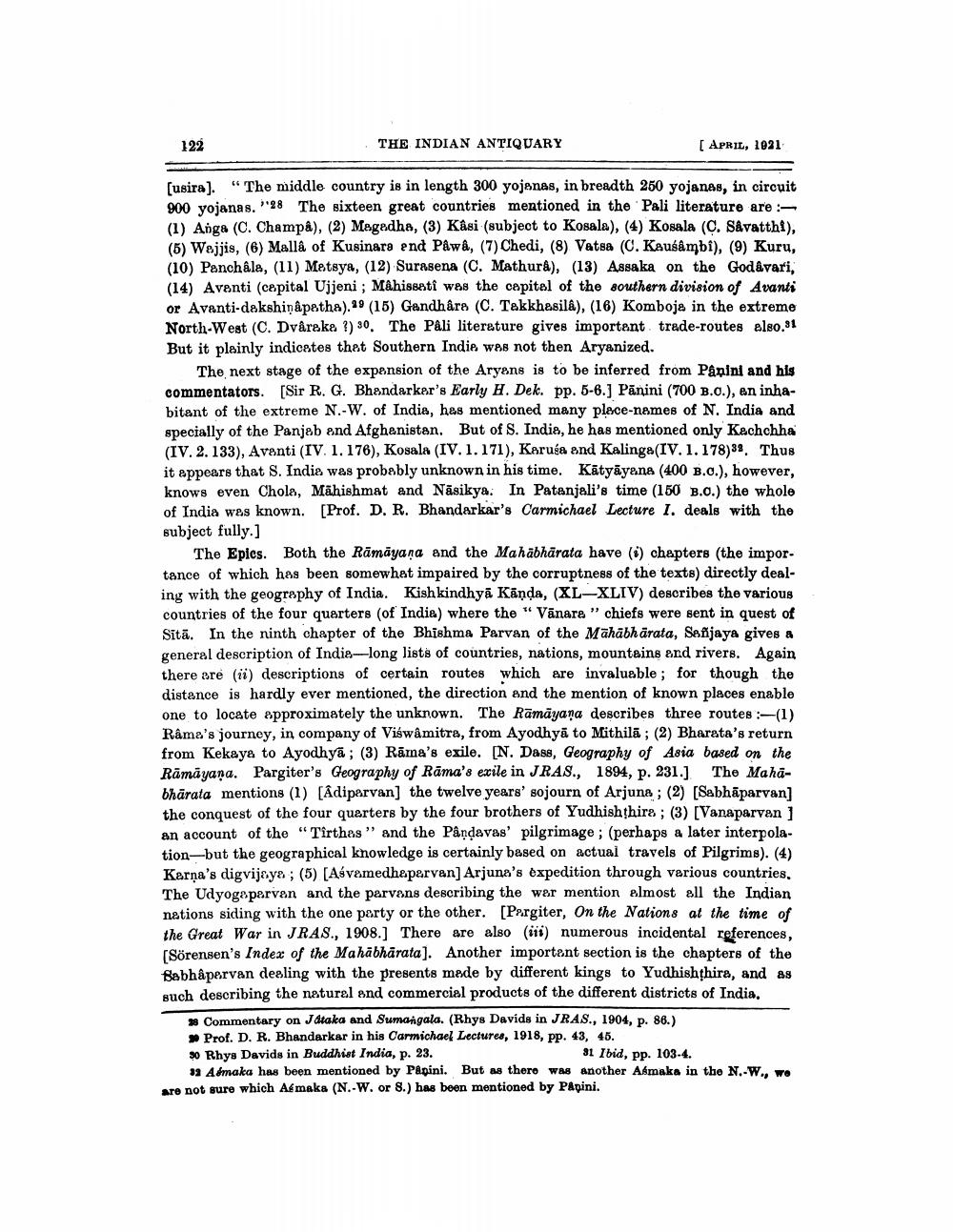________________
122
THE INDIAN ANTIQUARY
[APRIL, 1921
[usira]. "The middle country is in length 300 yojanas, in breadth 250 yojanas, in circuit 900 yojanas. 28 The sixteen great countries mentioned in the Pali literature are:(1) Anga (C. Champâ), (2) Magadha, (3) Kâsi (subject to Kosala), (4) Kosala (C. Sâvatthi), (5) Wajjis, (6) Mallâ of Kusinara end Pawâ, (7) Chedi, (8) Vatsa (C. Kausâmbî), (9) Kuru, (10) Panchâle, (11) Matsya, (12) Surasena (C. Mathura), (13) Assaka on the Godavari, (14) Avanti (capital Ujjeni; Mâhissatî was the capital of the southern division of Avanti or Avanti-dakshinapatha). 29 (15) Gandhâre (C. Takkhasilâ), (16) Komboja in the extreme North-West (C. Dvâraka ?) 30. The Pâli literature gives important trade-routes also.31 But it plainly indicates that Southern Indie, was not then Aryanized.
The next stage of the expansion of the Aryans is to be inferred from Pânini and his commentators. [Sir R. G. Bhandarker's Early H. Dek. pp. 5-6.] Panini (700 B.C.), an inhabitant of the extreme N.-W. of India, has mentioned many place-names of N. India and specially of the Panjab and Afghanistan. But of S. Indie, he has mentioned only Kachchha (IV. 2. 133), Avanti (IV. 1. 176), Kosala (IV. 1. 171), Karusa and Kalinga (IV. 1.178)32. Thus it appears that S. India was probably unknown in his time. Katyāyana (400 B.C.), however, knows even Chola, Mahishmat and Nasikya. In Patanjali's time (150 B.C.) the whole of India was known. [Prof. D. R. Bhandarkar's Carmichael Lecture I. deals with the subject fully.]
The Epics. Both the Rāmāyaṇa and the Mahabharata have (i) chapters (the importance of which has been somewhat impaired by the corruptness of the texts) directly dealing with the geography of India. Kishkindhya Kanda, (XL-XLIV) describes the various countries of the four quarters (of India) where the "Vanara" chiefs were sent in quest of Sītā. In the ninth chapter of the Bhishma Parvan of the Mahabharata, Sanjaya gives a general description of India-long lists of countries, nations, mountains and rivers. Again there are (ii) descriptions of certain routes which are invaluable; for though the distance is hardly ever mentioned, the direction and the mention of known places enable one to locate approximately the unknown. The Rāmāyaṇa describes three routes :-(1) Rama's journey, in company of Viswâmitra, from Ayodhya to Mithila; (2) Bharata's return from Kekaya to Ayodhya; (3) Rama's exile. [N. Dass, Geography of Asia based on the Rāmāyaṇa. Pargiter's Geography of Rama's exile in JRAS., 1894, p. 231.]. The Mahabhārata mentions (1) [Adiparvan] the twelve years' sojourn of Arjuna; (2) [Sabhāparvan] the conquest of the four quarters by the four brothers of Yudhishṭhira; (3) [Vanaparvan ] an account of the "Tirthas" and the Pânḍavas' pilgrimage; (perhaps a later interpolation-but the geographical knowledge is certainly based on actual travels of Pilgrims). (4) Karna's digvijaya; (5) [Aśvamedhaparvan] Arjuna's expedition through various countries. The Udyogaparvan and the parvans describing the war mention almost all the Indian nations siding with the one party or the other. [Pergiter, On the Nations at the time of the Great War in JRAS., 1908.] There are also (iii) numerous incidental references, [Sörensen's Index of the Mahabharata]. Another important section is the chapters of the Babhâpervan dealing with the presents made by different kings to Yudhishthira, and as such describing the natural and commercial products of the different districts of India.
18 Commentary on Jataka and Sumangala. (Rhys Davids in JRAS., 1904, p. 86.) Prof. D. R. Bhandarkar in his Carmichael Lectures, 1918, pp. 43, 45.
30 Rhys Davids in Buddhist India, p. 23.
31 Ibid, pp. 103-4.
32 Aémaka has been mentioned by Papini. But as there was another Asmaka in the N.-W., we are not sure which Asmaka (N.-W. or 8.) has been mentioned by Papini.




